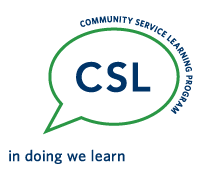
WELCOME
What is it that I am doing that will help me stand out?

It is community service learning or otherwise CSL, an opportunity to learn and expand our knowledge. CSL is created to help aid students connect ideas learnt in class and apply it using hands on experience. This is an extracurricular activity that gives you experience beyond just the scope of a classroom. It is important to broaden your knowledge through real life situations and critically thinking your way through them. It is essential to have skills, such as detailed-oriented as it helps you be particular and analyze with accuracy. One of the biggest components that come with every project is the responsibility. Being responsible and managing deadlines is an effective trait of any leader. All of these qualities are obtained by working in a CSL placement.
As for me, CSL is important as it will give me a new set of skills that I can use in collaborative settings or individual projects. Joining CSL and participating in it not only helps add more to my CV, but it helps me connect with different types of personalities. It is crucial to get to network and get to know people in order to get a hold of new experiences. In this experience, the best part is I get to connect the topics learnt in class to the work I am doing. Being able to make connections is an essential part of successful learning.
What is it that I am doing that will help me stand out?


TAIL-NOSE
QUIVER
But, what is the pupose of all of this?

The study focuses on finding more about the reproduction in vertebrates, in particular zebrafish (Danio rerio), as it has not been attempted before. The main hormone involved in reproductive processes is luteinizing hormone (LH) which is an anterior pituitary hormone. It is responsible for gonadal development (forms the testes in males and ovaries in females), sex hormones, and sex pheromone synthesis. It is crucial to activate this hormone in order for reproduction to occur; otherwise it leads to reduced fertility. Previous studies conducted here at uOttawa suggest that a peptide, secretoneurin (SN) stimulates the pituitary to release LH which leads to reproduction. The hypothesis being tested by Kimberly Mitchell, the coordinator of this experiment is that SN is a new reproductive peptide hormone. The goal is to determine the role of it in reproduction in knockout fish. A knockout fish is a genetically modified fish, in which a targeted gene (SgII) is disrupted in order to determine the effect of the new reproductive hormone. Therefore, recorded videos of spawning are analyzed to look for courtship behaviours. These behaviours will aid in determining if the injected SN or pheromones in water tanks can rescue spawning success in the knockout fish. SgII is a precursor protein called secretogranin, which through proteolysis (breakdown of proteins into smaller polypeptides) transforms into SN. A SgII knockout fish is used in order to eliminate the function of SgII/SN and be able to draw comparisons that conclude SN is a new reproductive hormone.
The Zebrafish courtship analysis behaviour experiment is based on analyzing zebrafish behaviours during spawning. Spawning is the reproduction method male and female zebrafish use to release the sperm and egg into water. These 2 hour videos are pre-recorded with either pheromones (a chemical substance used to trigger a response) or peptides injected into the water where male and female zebrafish are present. The main goal is to analyze the video for courtship behaviours, quiver and tail-nose. Courtship behaviours are methods used by species to choose their mate based on performance, for example a male fish chasing the female in order to spawn. The first behaviour, quiver is usually seen when the male and female fish form an s-shape and travel together for 1-5 seconds. The more frequent behaviour is tail-nose, which is seen when the male fish approaches the female and makes contact with the tail. The objective is to identify these behaviours as carefully as possible and then to note the times in excel as the video is analyzed. It is important to be very attentive, as the behaviours can occur multiple times in the same second. For example: tail-nose may occur over a 100 times in just the first 10 minutes of the video.
